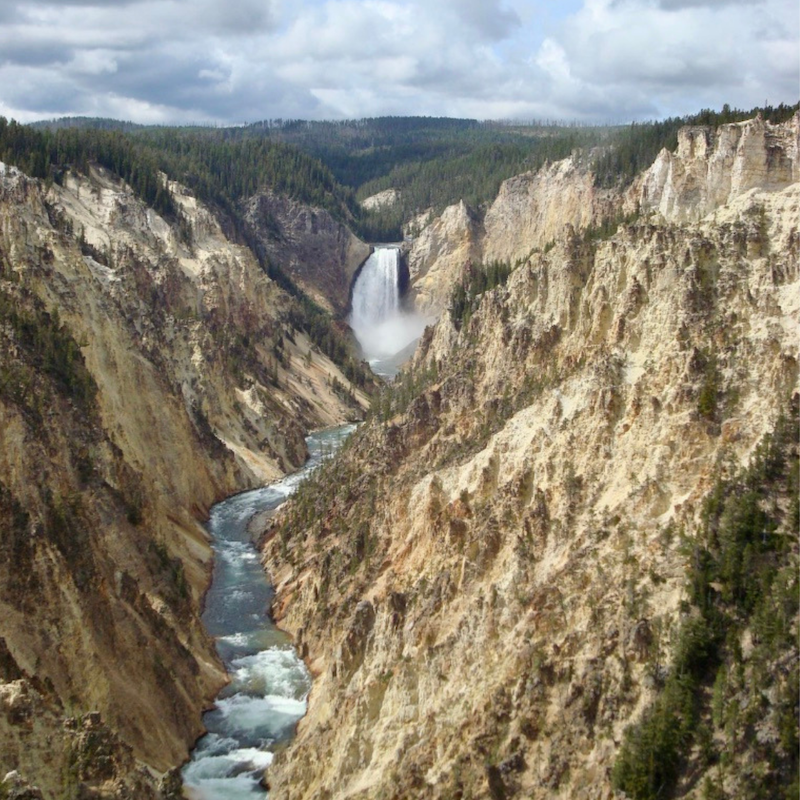
Most of Yellowstone’s signs are posted along roads, at trailheads, or in front of points of interest. Sometimes, though, they’re situated down the trail—a billboard of sorts in the woods. We once came upon such a sign on the gentle beginnings of Uncle Tom’s Trail, its post planted next to the pines that towered overhead and filtered the light of the afternoon sun.
Our descent wouldn’t stay gentle for long. We were hiking into the Grand Canyon of the Yellowstone and we knew that at the end of the gentle, earthen path we’d find a steep steel staircase. Numbering more than three hundred steps, the long flight of stairs would take us five hundred feet into the canyon for a closer view of the Yellowstone River’s plunge over the Lower Falls.
When “Uncle” Tom Richardson, the trail’s namesake and guide during the late 1890s and early 1900s, shepherded his customers into the canyon, they didn’t have the luxury of hiking boots or steel staircases. They climbed in over a series of wooden ladders, the women wearing long, cumbersome dresses and heeled, buttoned boots. It was dangerous then and it’s dangerous today, hence its sign:
You are entering an area of striking beauty with sheer cliffs and unstable footing.
Help us protect this area. Use only the constructed trails.
Climbing out along the rim or into the canyon can be dangerous and is prohibited by law.
The sign startled me. First, we were outdoors, in the mountains, in Yellowstone, which is to say, in the wilderness. We were surrounded by striking beauty. Beyond that, we’d been close to all manner of danger all week long. “Beautiful” and “dangerous” characterized trails (and even boardwalks) park-wide. Beyond that, the park service had deviated from its typical style of short admonishments and used verbose language bordering on romantic.
That they felt the need to point out to hikers that they were entering an area that was beautiful and dangerous in a wilderness characterized by both left me confused. Until, a few years later, when a first-time Yellowstone visitor fell into the canyon. It wasn’t that he fell in that cleared my confusion. It was why.
He was on his way to do what multitudes of people do every summer without incident—walking from his car to a viewing deck above the Lower Falls. Overwhelmed by the beauty of the setting and ignoring the danger of the sheer cliffs, he started to run. And take pictures. At the same time.
This is how he approached the canyon, so engrossed in what he saw that he ran off the trail, past the boulders meant to hem in the curious and the careless and save us from ourselves. With his eyes on the view rather than his footing, he slipped on some unstable rocks and slid forty feet down a drainage into the canyon.
Unlike others who have fallen into the thousand-foot chasm, he lived.
When I read his story, I thought about the sign on Uncle Tom’s Trail. I wondered if part of the work of life is to learn to see and see rightly—to look past the difficulties and distractions of everyday life and recognize not only the world around me but also the One who created it. When I considered a man so overcome by what he saw he ran right into it, the sign on Uncle Tom’s Trail made more sense. Both that man and I need the sign but for different reasons. He needed to be warned to pay attention to his feet. I need to be reminded to open my eyes.
God uses Yellowstone’s trails—steep ones, flat ones, dull ones, and striking ones— to help me understand how to navigate life’s trials by faith rather than by autopilot, by fear, or by anything else. This is just one reason to care about wilderness places like Yellowstone. It’s what it’s there for.
🧭 What helps you navigate the landscape of life by faith?
take heart & happy trails 🥾
p.s. Exciting book news! Waking Up in the Wilderness: A Yellowstone Journey will be available on October 21 and I couldn’t be more happier! You can learn more here and keep up with book news here.
I’m linking this tale from the trail at #tellhisstory, InstaEncouragements, Let’s Have Coffee, and Grace & Truth.
I wonder if this sign was worded differently specifically because some might ignore the “normal” signs, figuring they know what the signs will say.
This is such a poignant reminder that creation is much bigger and wilder than we know, and that we need to be careful instead of plunging in unawares.
You’re exactly right, and it’s why I often read famiiar passages in less familiar versions of the Bible!
This was such an interesting and beautiful reminder. God has given us His Word to keep us on the right, safe, and good path. He has given us both instructions and warnings, and it is up to us to heed them. Natalie, I’m so glad you continue to share the beauty of the Yellowstone and your insight!
He has! Isn’t he good? Thanks for the encouragement Joanne. It is much appreciated.
What helps me navigate is the memory of God’s faithful directions in the past!
I love your answer! Remembering what God has already brought us through is vital for navigating well in the present!
This is a fabulous reminder of why we are given instructions and warnings. Better yet this is just an enticing read. Thank you for sharing your experience at Yellowstone and beyond.
Thanks so much for your kind words. I’m so glad you stopped by today.
What a great analogy! And what a magnificent Creator God who would provide such beauty for us to enjoy. But like so many things in life, it can only be enjoyed and fully appreciated within the proper guidelines.
True in every way. Thanks for being here today.